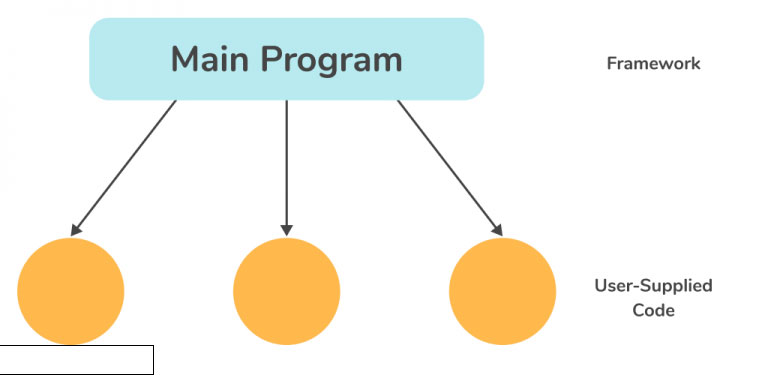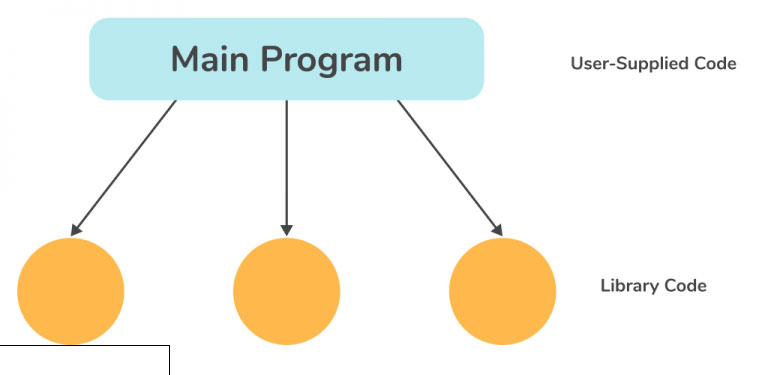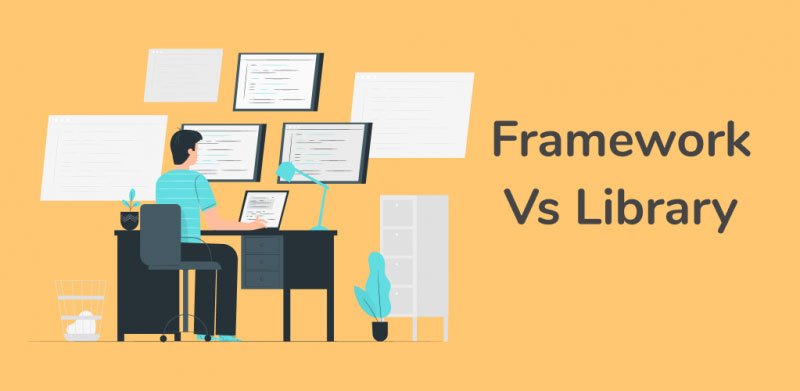In programming, libraries and frameworks are both tools that assist developers in building software applications efficiently. However, there are distinct differences between the two.
Before we delve into these key differences, it will be important to make a distinction between 2 concepts in programming that are very important, so as to understand how frameworks and libraries work.
Table of Contents
- Differences between front-end and back-end development
- What are frameworks and examples in front-end & back-end development?
- What are libraries and examples in front-end & back-end development?
- 7 Key differences between Libraries and frameworks
- 3 frameworks we recommend for front-end developers
- 3 frameworks we recommend for back-end developers
- Conclusion
- FAQs
Differences between front-end and back-end development

Ah, front-end and back-end development, two crucial aspects of web development. Allow me to explain the differences between the two:
Front-end development, also known as client-side development, focuses on everything that the users see and interact with on a website or application. It involves writing code using programming languages such as HTML, CSS, and JavaScript to create the user interface (UI) and user experience (UX).
Front-end developers are responsible for crafting visually appealing and user-friendly interfaces, ensuring responsiveness, and optimizing performance.
Back-end development, on the other hand, refers to the server-side of web development. It involves building the behind-the-scenes functionalities and infrastructure that power a website or application.
Back-end developers usually work with server-side programming languages such as Python, Ruby, Java, or PHP, and frameworks like Flask, Ruby on Rails, Spring, or Laravel. Their tasks involve handling data storage, server management, database integration, user authentication, and implementing business logic.
To summarize:
– Front-end development focuses on the presentation layer, creating user interfaces, and making them visually appealing and interactive.
– Back-end development deals with the server-side, handling data, managing the server, and implementing the business logic. Both front-end and back-end development work hand-in-hand to create a complete web application or website.
Effective collaboration between front-end and back-end teams is essential to ensure seamless functionality and a great user experience.
As you can see these are the building blocks for frameworks and libraries used in programming. Based on the type of developer you are, you will have to select a type of framework or library in your field of expertise.
Let’s elaborate more on what a framework is, and some examples both in front-end and back-end development.
What are frameworks and examples in front-end & back-end development?

Frameworks are pre-built software tools that facilitate application development. They provide a structure, libraries and ready-to-use functionalities to speed up the development process.
With regard to web development, here are a few examples of frameworks used on the front-end and back-end:
Front-end:
- Angular: A JavaScript framework developed by Google, used for building scalable web applications.
- Vue.js: A lightweight, progressive JavaScript framework, suitable for creating simple to complex user interfaces.
Back-end:
- Express.js: A minimalist, flexible Node.js framework for building web applications and APIs.
- Django: A high-level Python framework that follows the MVC design model for fast web application development.
- Ruby on Rails: A Ruby framework that favors usability and convention over configuration for web application development.
- Laravel: Laravel is an open-source PHP framework, which is robust and easy to understand. It follows a model-view-controller design pattern. Laravel reuses the existing components of different frameworks which helps in creating a web application. The web application thus designed is more structured and pragmatic.
These examples are just a sample of the many frameworks available. Each framework has its own advantages and peculiarities, so it’s important to evaluate them according to the specific needs of your project.
What are libraries and examples in front-end & back-end development?

In front-end development, libraries are commonly used to simplify and enhance the process of building user interfaces. Some popular front-end libraries include:
- React: A JavaScript library for building reusable UI components. It allows you to create interactive user interfaces efficiently.
- JQuery: A fast and concise JavaScript library that simplifies HTML document traversal, event handling, and animation. It makes it easier to interact with the DOM (Document Object Model) and create dynamic web pages.
On the other hand, back-end development libraries are not readily available. Libraries a primarily used for front-end development and sometimes come as packages in back-end development to perform functions frameworks can’t do on their own.
Frameworks, and Libraries should be used only after mastering, Data Structures and Algorithms under the programming language the later, and the former was built with.
These are just a few examples, and there are many more libraries available for both front-end and back-end development. The choice of library often depends on the specific requirements of your project and the programming language you are using.
Let’s delve into the key differences between libraries and frameworks. Below are 7 key differences between libraries and frameworks.
7 Key differences between Libraries and frameworks

In programming, libraries and frameworks are both tools that assist developers in building software applications efficiently. However, there are distinct differences between the two. Let’s delve into the key differences between libraries and frameworks.
1. Purpose:
- Libraries: Libraries are collections of prewritten code that provide specific functionalities, such as data manipulation, mathematical operations, or user interface components. Developers can choose to use specific functionalities from a library in their projects as needed.
- Frameworks: Frameworks, on the other hand, are more comprehensive and provide a structure for building applications. They include libraries, tools, and other components designed to support a specific development environment or domain.
2. Control flow:
- Libraries: When using a library, developers retain control over the application’s overall flow. They can choose which parts of the library to use and incorporate them into their code.
- Frameworks: Frameworks dictate the overall flow and structure of an application. Developers follow the predefined architecture and patterns established by the framework, limiting their control over the flow of the application.
3. Inversion of Control:
- Libraries: In library-driven development, developers have control over the flow and structure of their code. They decide when and how to invoke library functions.
- Frameworks: In framework-driven development, the framework controls the flow. Developers need to follow the predefined structure and patterns provided by the framework, including when to invoke framework functions.
4. Flexibility:
- Libraries: Libraries offer more flexibility as developers can selectively utilize desired functionalities without being bound by the library’s structure or patterns.
- Frameworks: Frameworks provide less flexibility as developers are required to adhere to the framework’s rules and guidelines in order to benefit from its structure and features.
5. Learning Curve:
- Libraries: Libraries typically have a shorter learning curve as they target specific functionalities. Developers can pick and choose libraries based on their requirements.
- Frameworks: Frameworks often have a steeper learning curve since they encompass multiple components and emphasize adherence to specific architectural patterns.
6. Code Ownership:
- Libraries: Developers using libraries retain the ownership of their application code and can choose when and how to incorporate library functionalities.
- Frameworks: Developers using frameworks have less code ownership as a significant portion of the application code will be dictated by the framework’s structure and patterns.
7. Development Approach:
- Libraries: Libraries promote a more piecemeal and modular approach to development, where developers have more freedom to mix and match various libraries to suit their needs.
- Frameworks: Frameworks promote a more structured and opinionated approach to development. They provide a specific set of tools and patterns to follow, which can lead to faster development once the learning curve is overcome.
It’s important to note that these differences are generalizations, and there can be variations depending on specific libraries and frameworks.
Furthermore, in order to guide you in choosing the framework or library suited for your project, below are some key recommendations.
Subscribe to our newsletter and receive valuable tech information from The Web Edge.
3 frameworks we recommend for front-end developers
- React: React is a widely-used JavaScript library for building user interfaces. It allows developers to create reusable UI components, making it easier to manage complex applications. React’s virtual DOM rendering and component-based architecture provide efficient performance and a great development experience. It is supported by a vibrant community and has a rich ecosystem of libraries and tools.
- Angular: Angular is a powerful TypeScript-based framework developed by Google. It provides a complete solution for building large-scale, feature-rich applications. Angular offers a strongly typed codebase, two-way data binding, dependency injection, and reactive programming with RxJS. It also includes features like routing, form handling, and internationalization, making it suitable for enterprise-level projects.
- Vue.js: Vue.js is a progressive JavaScript framework that gained popularity for its simplicity and ease of integration. It is often referred to as the “lightweight” alternative to React and Angular. Vue focuses on the view layer and can be incrementally adopted into existing projects. It offers a flexible and intuitive API, reactive data binding, component reusability, and a comprehensive ecosystem. Vue.js is known for its gentle learning curve and fast rendering performance.
These frameworks have their own strengths and cater to different development preferences. Feel free to explore them further and choose the one that best fits your project requirements and personal preferences.
3 frameworks we recommend for back-end developers
As a back-end developer, there are several frameworks that I recommend for building robust and efficient applications. Here are three popular options:
- Express.js: Express.js is a minimalistic and flexible web application framework for Node.js. It provides a set of features and utilities to build web applications and APIs quickly. Express.js is known for its simplicity and easy integration with other libraries, making it a popular choice among developers.
- Django: Django is a high-level web framework written in Python. It follows the Model-View-Controller (MVC) architectural pattern and offers a comprehensive set of tools and libraries for building scalable and secure web applications. Django includes features like an ORM (Object-Relational Mapping) system, authentication, and admin interface, making it a powerful framework for complex applications.
- Ruby on Rails: Ruby on Rails, often referred to as Rails, is a full-stack web application framework written in Ruby. It focuses on convention over configuration, which means that it provides sensible defaults, reducing the amount of code needed to build an application. Rails promotes rapid development and follows the MVC pattern, making it a popular choice for startups and small to medium-sized projects.
These frameworks have strong communities, extensive documentation, and a wide range of plugins and libraries, which can significantly speed up development time and provide robust solutions for back-end development. Remember to choose a framework based on your project requirements, programming language preference, and the ecosystem you’re most comfortable working with.
Conclusion
In summary, the difference between frameworks and libraries is very thin; explaining why these two concepts are used interchangeably .Nevertheless, All websites require front-end and back-end development. Front-end development focuses on the visual aspects of a website — the part that users see and interact with. Back-end development comprises a site’s structure, system, data, and logic. Together, front-end and back-end development combine to create interactive, visually pleasing websites and web applications.
Both types of developers need strong coding skills. Front-end devs use programming languages to bring the client side of a site to life. This development takes technical, creative, and communication skills. Back-end developers use server-side programming languages to ensure that websites function properly.
Back-end devs remain in high demand for their technical expertise. According to March 2023 PayScale data, back-end developers earn $90,652 on average, while front-end developers make an average of $80,796.
FAQs
- What skills does a front-end developer need?
Frontend developers utilize different web technologies to change coded data into user-friendly interfaces. Many among these are Cascading Style Sheets (CSS), JavaScript, HyperText Markup Language (HTML), etc. Mentioned below are brief explanations of these technologies that frontend developers must be acquainted with.
- How do I prepare for a front-end developer interview?
When you’re preparing for your Front-end developer interview, try to code most of your layout without taking a glance at the result till the end. If CSS, HTMLare the most important aspect of front-end development, then JavaScript tops the list of important skills to own. Organisations will spend a lot of time during your interview to test your understanding of Javascript.
- Which is better, a library or a framework?
You can probably already see if you have worked with both that normally, code libraries are used to solve a specific problem or to add a specific feature to your program. Frameworks, on the other hand, provide a much more generic and reusable approach. While neither pattern is inherently better, you need to know which pattern is appropriate for the problem at hand.
- What is the difference between JS (JavaScript) libraries and frameworks?
JavaScript libraries differ from frameworks in that they contain prewritten code snippets that can be used (and reused) for common JavaScript functions. Unlike JavaScript libraries, JavaScript frameworks are a full toolkit for shaping and organizing your web application. Frameworks describe how developers design applications.
- Is flask a framework or library?
Flask is a micro web framework written in Python that does not require any specific tools or libraries.
- Is Ajax a framework?
Yes, an Ajax framework is a cross-browser framework that allows developers to easily develop Ajax-based internet applications.
Très édifiant cet article.
Merci Endomba, N’hésitez pas à partager. Nous préparons d’autres articles !
Thank you for your positive feedback. we are working hard to bring you more content.